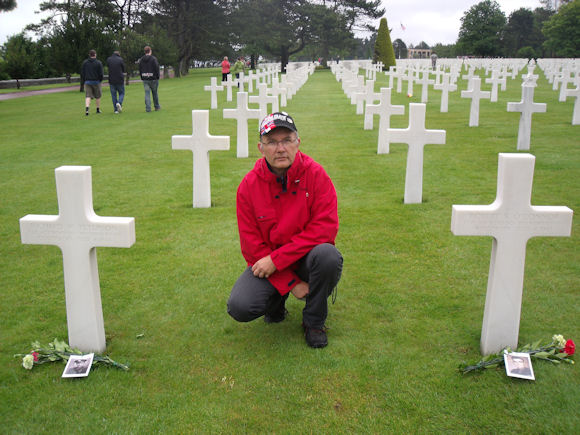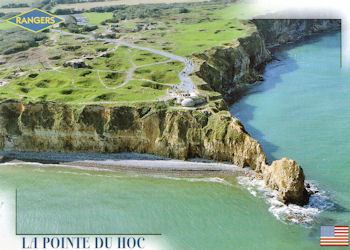Submissions of 303rd Bomb Group related stories and articles are most welcome.



July 17, 2011
Volume III, Issue 7
www.303rdBG.com
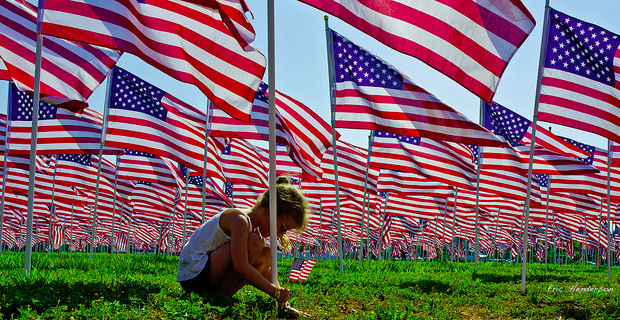
1,500 American flags flying at Healing Field "Flags of Remembrance" in Murfreesboro, TN
(photo courtesy of Eric Henderson Photography)
That was the end of my world – the war to me was over . . .
by Sgt George J. Morrison
Originally published in the September 1986 "Hell's Angels Newsletter"
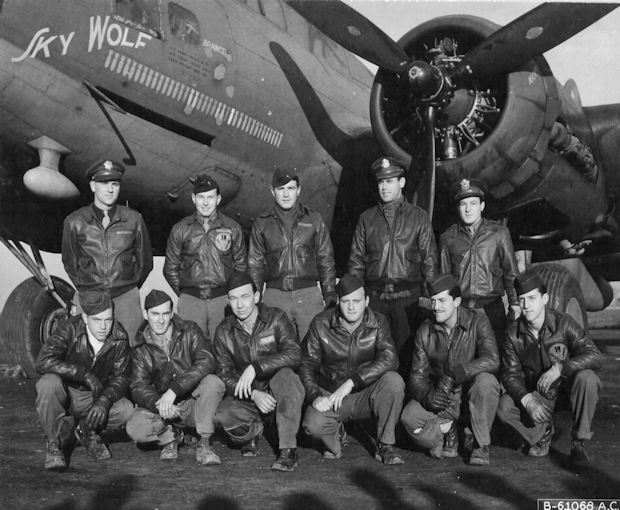
WILLIAM C. DaSHIELL CREW - 358th BS
(Back L-R) 1Lt Walter R. Kyse (Instructor Pilot), 2Lt William C. DaShiell (P-KIA),
2Lt Hilton C. Mabie (CP-KIA), 2Lt Thomas A. Sutherland (N-KIA), 2Lt Don J. DeLaura (B)
(Front L-R) Sgt Arthur H. Robinson, Jr. (BT-KIA), S/Sgt Bernard J. Radebaugh (R-KIA),
S/Sgt Robert L. Stevenson (E-KIA), Sgt Clifford M. McKinney (TG-KIA),
Sgt Robert J. Owen (WG-KIA), Sgt George J. Morrison (TG)
The following is the story of our crew and my recollection of our adventure as best as I can recall.
With our preliminary training in the States completed, we finally took off from an east coast port for our flight across the ocean, an uneventful trip concluded by our landing in Scotland. After several days in the British Isles, we finally landed at our permanent base located in Molesworth, England, a typically English rural countryside, an area dotted with landing strips and barracks, repair depots, and aid stations.
We were assigned our barracks and a place on the field to park our ship, very matter of course, we were just another combat crew that had come here to do a job.
After a day or so, we were assigned a combat instructor, Lt. Walter Kyse, the officer in the left rear of our picture. He had flying experience around England and the Continent, so for a period of a few weeks he flew with us, teaching us the intricacies of flying over a strange land. (He was subsequently killed while on a mission over Germany).
Our first narrow escape: We had been in England only a few days when we were ordered to fly to the southern part of the island to pick up some emergency plane repair parts. On a trip like this we could get flying time and practice, as well as serve a useful purpose.
Arriving at the field we found it to be on the very edge of the ocean practically on the beach. We landed the ship, all climbed out, and started across the field to the hangars. Out over the ocean, flying swiftly and scarcely 50 feet above the water we saw nine fighter aircraft approaching the field, and in less time than it would take to tell, they were now near enough to see clearly - they were Messerschmitts.

Messerschmitt Bf 109
We threw ourselves to the ground and they roared overhead, their guns blazing as they strafed the field from end to end. Miraculously we escaped being hit, why I'll never know, but with all that lead flying around no one was even scratched. Others on the field were not so lucky, there were 11 British Women's Army corps killed and 23 wounded. Several planes and hangars were set afire, but these were soon extinguished, the dead and the wounded were cared for, and the activity continued as before. Thus, at first glance we saw some of the vaunted Luftwaffe.
After flying daily for about a month we were now considered ready to go on a mission, so on November 25, 1943 (Thanksgiving Day) we were notified that the next day we were to have our first combat mission to Bremen in northwest Germany.
None of us slept much that night, we were nervous and maybe a little scared, frightened at the realization that at last we were ready. Up to now we had been pretty cocky, we had travelled extensively in comparative safety, but this was something different.
We arose before dawn the next day, dressed and hurried over to the briefing room. Here we learned all the pertinent facts of time and course, altitude and target. We were told how the weather would be and where to expect the opposition. The details over, we returned for breakfast. I think mine consisted solely of coffee, I'm sure I couldn't have eaten anything.
Now the time had arrived, we hurried out to the ship, (Yardbird) climbed aboard, and made hasty last minute checks of our gear. Guns in order, ammunition stowed properly, instruments in working order, all stations on the intercommunications system O.K., and a myriad of other details. The tenseness abated somewhat as everyone busied himself with his appointed tasks.
The first ships were now taking off and now came our order from the control tower; we taxied down the runway, lifted gently into the air and were off. We circled around with the other planes gaining altitude and getting into position in the formation and when everything was in order we headed for the Channel and Germany.
This trip wasn't just uneventful. The flak was intense and the Jerries fought savagely, but we arrived over the target, dropped our bombs and headed back home safe and sound - a few holes in the ship but everyone on board safe and feeling quite elated over our success. Our first one was over. Some of the other ships failed to return, but we were O.K., and for the moment that was all that mattered.
Second Mission - Bremen - November 29, 1943; This mission followed the same pattern as the first one before with a few exceptions. The flak was more intense and there was a considerably greater number of enemy fighters. They dove in furiously, firing their guns and only pulling out of the dive soon enough to avert a collision. Our ship was struck repeatedly by flak, machine gun and cannon fire. A lucky hit knocked our oxygen system out of commission and shortly all six gunners had lost consciousness from lack of oxygen.
When DaShiell, the pilot, found he couldn't raise anyone on the intercom he directed DeLaura, the bombardier, to go back into the ship and see what was wrong. He immediately discovered the cause and hurriedly took the emergency oxygen bottles and hooked them to our masks. There weren't enough oxygen bottles to go around, so that meant reviving one and then taking his oxygen bottle from him to revive another.
The enemy planes sensed that something was wrong because none of the guns were firing and several Messerschmitts converged upon us and raked the ship from nose to tail. During the ensuing evasive action by the pilot, we lost altitude and soon were hopelessly separated from the formation and an easy prey for the enemy.
The engineer started to fire flares to summon aid and presently three P-47's were dispatched to aid us. They succeeded in driving off the enemy and protected us until we got over the target, dropped our bombs and headed home.
As soon as it was safely possible, we dropped to a lower altitude where we no longer needed oxygen and the gunners were then able to maintain consciousness. We limped back to the base and when we climbed out of that and saw the condition of it we could then agree with others who previously had said, "It's a damn good airplane."
The ship was so badly damaged that it was first decided it would have to be scrapped, but upon further examination they decided it could be repaired. Those repairs took five weeks. The tail wheel had been shot away, the vertical stabilizer on the tail had a hole in it big enough to drive a car through, and the control cables had been shot away. The hydraulic and oxygen systems had to be replaced, new wing gasoline tanks were installed, and she was patched from stem to stern. She really took a beating on that trip, but she brought us back safe and sound.

B-17F #41-24577 Hell's Angels
The next raid was December 1, 1943 to the city of Solingen in the Ruhr Valley. As the result of the extensive damage to our regular ship, for this raid we were assigned a battle scarred veteran of 46 raids named the "Hell's Angels." This ship had been flown by various crews and was soon due to be retired from service. It was a mass of patches externally, but on the whole it was mechanically O.K.
This raid on Solingen was quite the same as the previous two, the flak was more intense, in fact so thick that returning pilots stated that they could have lowered their landing gear and taxied over it.
This city is of vital interest to Germany in that here is manufactured a great amount of the steel that is needed for war. For this reason, this area is very ably protected by anti-aircraft fire as well as fighter aircraft. Despite the difficulties, however, we were able to reach our target and drop our bombs, wheel around and head for home. We returned to our base safe and sound and considered ourselves very lucky to be still in the fight.
To adequately paint a word picture of the utter confusion that exists over the target is almost beyond the realm of possibility – The noise of the anti-aircraft shells, the roar of motors of the fighters and bombers, the chatter of our guns, smoke of burning planes and exploding shells. The air becomes filled with debris from ships that explode, parts of wings or tails that are blown off, falling and burning fighters of ours and the enemy, the parachutes of airmen forced to bail out. All these contribute toward making the scene one of general pandemonium.
The next raid was to Bremen on December 16, 1941. I was not on this raid as I was grounded due to illness. Parker occupied my position in the tail. As I recall, the boys told me that this flight compared favorably with those that had preceded it. They used the "Hell's Angels" again and on her return she had some new holes to be patched. By now the repair crews were putting patches on the patches. As it had been decided to return this ship to the States for use in a war bond drive, and as she had been pretty badly battered in her last few raids, she was retired after this mission, rehabilitated and sent back home.
No one up to now had been injured, although there had been narrow escapes. We had seen so much action in this short time that we were beginning to wonder at times just how long this thing could last. The crews usually felt apprehensive when they returned from a raid, but after a few days they were anxious to get started on the next one.
Six days later, on December 22, 1943, they made another flight, this time to Osnabruck, another raid on which I was forced to remain at base. The anxiety of awaiting their return is almost as much strain as actually going along. On this raid too, Parker substituted for me. As the "Hell's Angels" had been grounded, they used another Fortress of the same type, but in apparently better shape. They returned again to the U.K., with the usual number of flak and bullet holes, the usual tenseness and exhaustion of mind and body.
Since I had now missed two raids and felt again as though I could get back to action, I requested that I be returned to duty. The doctor examined me and declared me fit for service, so on December 28, 1943, I was notified that I was to serve as a substitute gunner aboard another ship (my crew was not scheduled for this one). I was glad of this opportunity to make up these two lost raids so that I would be even with my crew and we could all finish our 25 missions together. Before this raid came off however, I was removed from the list because my crew was scheduled for a raid on the next day and I was to fly with them, and another gunner was substituted for me for the raid of the 29th. When that plane returned, that substitute gunner was taken out of the tail position - dead. As I look back now, I see that fate had already started to intercede for me.
The raid of December 30, 1943 and the next one of January 7, 1944, also to Ludwigshafen, followed the pattern of those before, the usual intense flak and attack by enemy fighters. On the raid of the 7th, the tail of our ship was hit several times by 20 mm. cannon fire, the explosion of one of these shells throwing me out of my seat and slightly injuring my back. Upon returning to base I had to see the doctor again, and once more I was grounded. By now I was beginning to believe everything was working against me. My injury wasn't serious, but as the doctor had decided for me there was nothing else I could do.
The next raid was on January 11, 1944 to Oschersleben. On this raid I was still grounded as a result of the previous raid. I attempted to have the doctor release me for duty but he advised that I would have to remain at home - a decision which probably saved my life.
On the morning of the 11th, we were routed out of bed about 4:30. It was a chilly, foggy morning, the ground covered with frost. I arose with the rest of the boys, had breakfast with them, went to the briefing, and before the take-off I helped them dress. They were all lighthearted and in a good mood, doing the usual kidding and fooling around. I walked out to the ship with them, saw them go aboard and wished them God speed and a safe return. Parker again occupied my position in the tail and there was a substitute bombardier in the nose. DeLaura, our regular bombardier had been chosen to be the lead bombardier for the entire squadron, his duty being to locate the target in his sights and then signal the rest of the planes in the squadron, all of them then dropping their bombs at precisely the same moment, thus laying a pattern over the entire target.
After they left, then began my worst part of the trip, sweating out their return. I went back to the barracks, made up the beds, hung up their clothes, and tried to stay busy so that the time would pass more quickly.
Came the time of the afternoon when they should return, so I hurried down to the end of the field so that I could spot them the instant they hove into view. Soon there was the drone of planes in the distance and they started to come back home. Plane after plane came in, nearly all of them firing flares to signal wounded men aboard or requesting special landing instructions due to being partially disabled.
Finally, I spotted one from my squadron and as soon as it had rolled to a stop I ran over to see what had happened. I asked the pilot of this ship where my ship was and he pointed in the direction from whence he came and said, "Out there. They got every plane in our squadron but ours. Your ship was flying directly in front of me and they received a direct hit just as they were going over the target. They fell out of formation and started down in a long glide, but the confusion of battle was so great we couldn't watch to see if any chutes left the ship. From the way they looked when we last saw them, they could have gotten out."
That was the end of my world - the war to me was over. From then on I lost interest in planes and bombing.
Our barracks housed 12 men, the non-commissioned members of two crews. Neither of those crews returned that day and I alone was left in the barracks that night - a night that was the longest and the loneliest of any I hope I ever must have. The next day I packed their belongings and saw to it that they were properly taken care of. Later that day I was moved to the hospital. I was finally moved to an evacuation hospital in the north of England and later embarked for the States in a hospital ship, arriving here on March 27, 1944.
I was sent to the Deshon General Hospital in Butler, Pa. only 30 miles from my home. My folks were able to visit me there and during my stay I had a three day pass at home. Being so close to home really was a tonic and soon I was improving. I was then moved to the hospital at Mitchell Field, New York. After two weeks I came home for a 21 day furlough, then returned to Atlantic City to spend a refreshing two weeks in the Ambassador Hotel. I was reassigned and sent to Avon Park, Florida where I am now employed as an instructor in the operation of the Caliber .50 machine gun.
I am well again, but shall never forget the grandest guys it was ever my great fortune to meet. I still pray that those reported missing will turn up and to those who died, you may be sure they died as heroes, every one. I hope this will give you some insight as to what we went through and will answer some of your questions you have asked. Maybe it will assuage your grief and give added hope that good news may still be forthcoming.
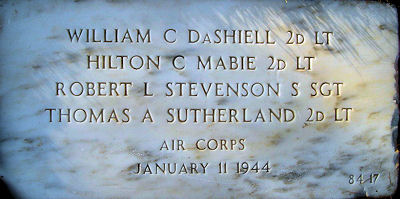 |
Author George J. Morrison rejoined his crew on December 26, 1997.
(Editor's note: Some of Morrison's facts, dates and missions in his narrative don't quite match the official records. The substitute tail gunner who was brought back to Molesworth mortally wounded is believed to be Sgt Robert A. Jeffrey. He was actually KIA on January 11, 1944, the same day the DaShiell Crew was lost. These discrepancies are probably due to a combination of errors on loading lists, last-minute substitutions and fading memories.)
The above story, without the epilogue, was originally published in the September 1986 issue of the 303rd Bomb Group Association's Hell's Angels Newsletter. It was printed without credit to the author, as he was unknown at the time. Hell's Angels Newsletter Editor Hal Susskind introduced the story with these comments:
I doubt if anyone can give me an accurate count of how many flight crews were assigned to the 303rd Bomb Group from its inception to its inactivation in Casablanca in 1945. I'm sure that the history of each crew would make wonderful reading. Unfortunately many of these will have to remain as the great untold stories of World War II – Unless through a stroke of fate they surface as the one outlined below did. Regrettably I do not have the name of the author.Much has changed in the 25 years since Hal published that issue of the Newsletter. The author is now easily identifiable as Sgt. George J. Morrison and the unknown number of flight crews Hal mused about is about 570.The story was forwarded to me by J. Ford Kelley who flew with the 303rd in the early days. Kelley wrote, "Just prior to leaving for the Seattle Reunion last year, a Glen Mabie called me. His brother was killed while serving with the 303rd and he wondered if I would take the attached material to the Reunion to see if anyone knew more about his brother's crew. By the time he had the material copied and mailed, I had left for the reunion."
Mabie in his letter wrote, "I'm enclosing a story that was sent to my mother by the tail gunner, to use as you see fit. I can't remember the name of the tail gunner, so I don't know how to handle it. By posting the picture of the crew at the reunion someone may identify the author and with his permission, it can be entered into the archives." His second letter along with a photo said, "My brother, Hilton C. Mabie is in the middle of the back row. The pilot's name was DaShiell which is the second man in from the left. The fourth man in is Tommy Sutherland from Suffren, N.Y. The tail gunner is bottom row, right. I don't remember any of the other names at this time. Please read the story and see if you can supply any information."
I can supply some. Oschersleben was a very rough mission. - Editor's Note -
Research like this is now simple due to the efforts of a small group of people.
Between 1987 and 1989 a team of 303rd BG veterans copied all 364 Mission Reports from the National Archives. The team of volunteer researchers included Ralph B. Adams, Casmir M. Bielski, William F. Dohm, James F. Donnelly, Robert J. Evans, Richard R. Johnson, Elroy C. "Al" Lehmann, Lewis E. Lyle, Gerson I. "Gus" Nadell, John Sanda, George V. Stallings, Jr. and Loy E. Tingley.
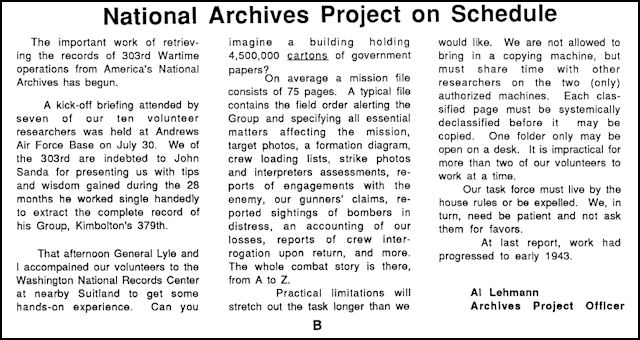
Update on the National Archive Research Project from the November 1987 Hell's Angels Newsletter
From those mission reports and other documents, LtCol Harry D. Gobrecht wrote his classic history of the 303rd Bomb Group (H), "Might In Flight - Daily Diary of the Eighth Air Force's Hell's Angels" and LtCol Edgar C. Miller extracted names and crews, creating a roster of nearly 9,000 303rd Bomb Group veterans.
These men blazed the trail that made it possible for me to place this historic information online and available to the world. We are all deeply in their debt.
![]()
by Peter G. Park, Commander's Action Group
JIOCEUR Analytic Center
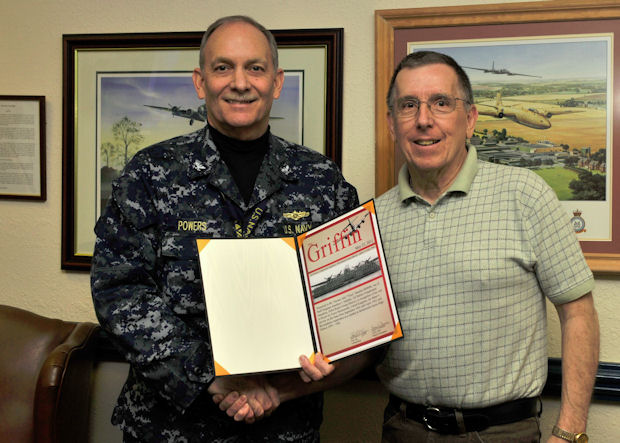
6/1/2011 - Royal Air Force Molesworth, England -- For Vince Dandini there was a triple reason to visit RAF Molesworth, the wartime home of the 303rd Bomb Group (Heavy) on May 25th.
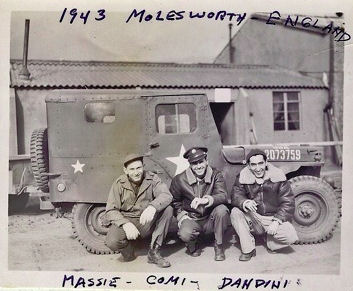 |
Secondly, his mother was one of some 250 British brides who married 303rd members (Molesworth holds more than top combat records among American bases!).
Thirdly, the younger Dandini had graduated from the small Molesworth Junior High School located on the base in the 1950's and 1960's when his father served a second tour in England, this time at Alconbury.
During the visit along with his wife Sally and his British cousins, Kevin and Pat Skipworth, Dandini was presented a special certificate recognizing his visit and the service of his father by JAC Deputy Commander, Navy Captain Gary Powers.
After touring the remaining "J-type" Hangar and the cold war ground launched cruise missile bunker, Mr. Dandini provided valuable insight to RAF Molesworth historian Peter Park on the late 1950's and early 1960's chapter in the base history.
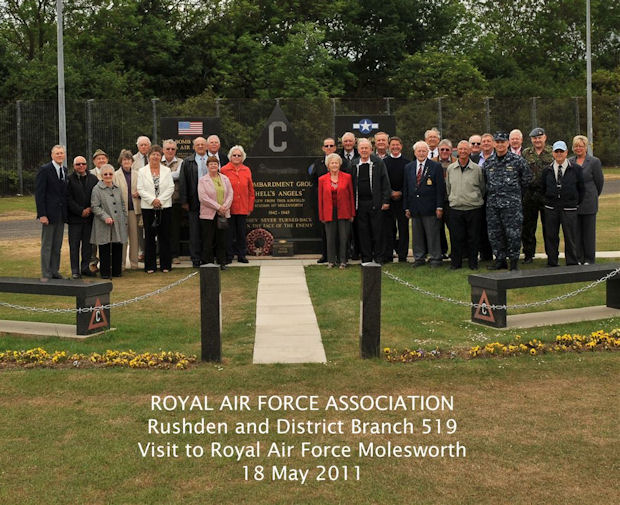
 Some had flown RAF bombers during the war and met American airmen then,
and for at least two of their wives, the Hershey bars provided with
lunch here brought tears as they reminded them of the generosity of
303rd Bomb Group airmen when they were little girls seeing their first
ever chocolate bar and ice cream at children's parties sponsored by the
303rd at Christmas or other holidays. Britain was on severe rationing
then and a visit to an American airbase was a real thrill.
Some had flown RAF bombers during the war and met American airmen then,
and for at least two of their wives, the Hershey bars provided with
lunch here brought tears as they reminded them of the generosity of
303rd Bomb Group airmen when they were little girls seeing their first
ever chocolate bar and ice cream at children's parties sponsored by the
303rd at Christmas or other holidays. Britain was on severe rationing
then and a visit to an American airbase was a real thrill.
Hosted at Royal Air Force Molesworth by JIOCEUR Deputy Commander, U.S. Navy Captain Gary S. Powers, and the Tribase Royal Air Force Commander, RAF Squadron Leader Andy Thayne, the group was given briefings on the three major units at today's RAF Molesworth during a working lunch.
Following a tour of base historical sites including the WWII hangar once visited by Her Royal Highness Queen Elizabeth (then Princess Elizabeth) in 1944, and the decommissioned cold war ground launched cruise missile bunker, the group concluded the tour.
The 18 May visit of the Rushden and District RAFA made clear the bonds between our two great nations and that the 'special relationship' recently reaffirmed by our Commander-in-Chief, President Barack H. Obama, and British Prime Minister David W. D. Cameron during the President's recent visit to the United Kingdom, have not diminished over the years.
![]()
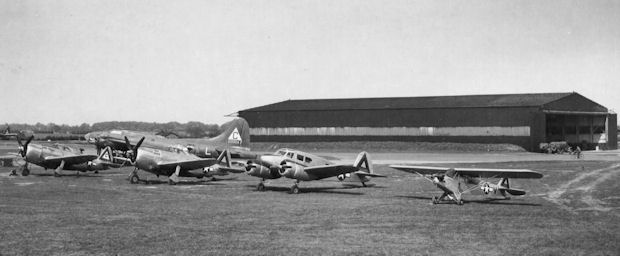
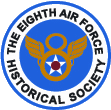
 8th AIR FORCE HISTORICAL SOCIETY
8th AIR FORCE HISTORICAL SOCIETYANNUAL REUNION
SHERATON WESTPORT – LAKESIDE CHALET
ST. LOUIS, MO – OCTOBER 11 – 16, 2011
Reunion and registration information are now available. See:
http://www.8thafhs.org/reunions.htm
Forced Landing near Aurora, Illinois
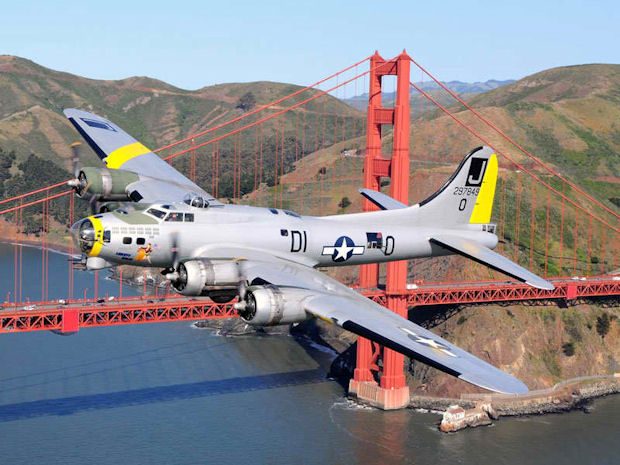
Statement from Liberty Foundation Chief Pilot Ray Fowler
June 14, 2011 - First, let me start off by sincerely thanking everyone for the outpouring of support that we are receiving. I am sorry that I have not yet had the opportunity to return the many phone calls, text or e-mails that I am receiving offering to help. Again, thank you for all of the kind words that we are receiving and for incredible offers to help emotionally, financially and/or with the recovery process. I hope this statement will help fill in a few details that everyone is wondering about that led to the loss of our "Liberty Belle".
Yesterday (June 13, 2011) morning, both our P-40 and B-17 were scheduled to fly from Aurora, Illinois to Indianapolis, Indiana. We were in Aurora for the weekend as a part of our scheduled tour. Over the course of the previous week, we completed a scheduled 25-hour inspection on the B-17 which was completed by Saturday. On Saturday, the weather stayed below the required ceiling to give any passenger flights, however the B-17 flew in the morning on a routine training proficiency flight, performing several patterns. Following the flight, other maintenance issues arose that required us to cancel our Sunday flying schedule for repairs. The maintenance performed has not been, in any way, associated to the chain of events that led to Monday's fateful flight, but is being considered in the preliminary investigation. However, due to the media's sensational (mis)reporting, there is a large amount of misinformation that continues to lead the news.
Here is what we do know… Flying in the left seat of the B-17 was Capt. John Hess. John has been flying our Liberty Belle since 2005 and one of our most experienced B-17 pilots. He is an active Delta Air Lines Captain with over 14,000 hours of flying experience and flys a variety of vintage WWII aircraft. In the right seat was Bud Sittig. While Bud is new to the Liberty Foundation this year, he is also incredibly experienced with over 14,000 hours of flying time in vintage and hi-performance aircraft. He is a retired Captain with Delta Air Lines.
The news misidentified the P-40 as flying chase during the accident. I was flying our P-40, however I had departed 20 minutes prior to the B-17's takeoff on the short flight to Indianapolis to setup for the B-17's arrival. The aircraft flying chase was a T-6 Texan flown by owner Cullen Underwood. Cullen is one of our rated B-17 Captains and an experienced aviator tagging along as a support ship.

The takeoff of both aircraft was uneventful and proceeded on-course southeast. Prior to exiting Aurora's airport traffic area, the B-17 crew and passengers began investigating an acrid smell and started a turn back to the airport. Almost immediately thereafter, Cullen spotted flames coming from the left wing and reported over the radio that they were on fire.
As all pilots know, there are few emergency situations that are more critical than having an in-flight fire. While an in-flight fire is extremely rare, it can (and sometimes does) indiscriminately affect aircraft of any age or type. In-flight fires have led to the loss of not only aircraft, but often can result in catastrophic loss of life. It requires an immediate action on the flight crew, as the integrity of aircraft structure, systems and critical components are in question.
Directly below the B-17 was a farmer's field and the decision was made to land immediately. Approximately 1 minute and 40 seconds from the radio report of the fire, the B-17 was down safely on the field. Within that 1:40 time frame, the crew shutdown and feathered the number 2 engine, activated the engine's fire suppression system, lowered the landing gear and performed an on-speed landing. Bringing the B-17 to a quick stop, the crew and passengers quickly and safely exited the aircraft. Overhead in the T-6, Cullen professionally coordinated and directed the firefighting equipment which was dispatched by Aurora Tower to the landing location.
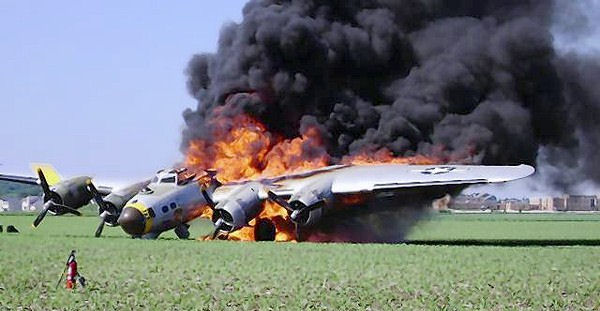
Unlike the sensational photos that you have all seen of the completely burned B-17 on the news, you will see from photos taken by our crew that our Liberty Belle was undamaged by the forced landing and at the time of landing, the wing fire damage was relatively small. The crew actually unloaded bags, then had the horrible task of watching the aircraft slowly burn while waiting for the fire trucks to arrive. There were high hopes that the fire would be extinguished quickly and the damage would be repairable. Those hopes were diminished as the fire trucks deemed the field too soft to cross due to the area's recent rainfall. So while standing by our burning B-17 and watching the fire trucks parked at the field's edge, they sadly watched the wing fire spread to the aircraft's fuel cells and of course, you all have seen the end result. There is no doubt that had the fire equipment been able to reach our aircraft, the fire would have been quickly extinguished and our Liberty Belle would have been repaired to continue her worthwhile mission.
Let me go on the record by thanking the flight crew for their professionalism. Their actions were nothing short of heroic and their quick thinking, actions and experience led to a "successful" outcome to this serious in-flight emergency. John and Bud (and Cullen) did a remarkable job under extreme circumstances and performed spectacularly. While the leading news stories have repeatedly reported the "crash" of our B-17, fact is they made a successful forced landing and the aircraft was ultimately consumed by fire. Airplanes are replaceable but people are not and while the aircraft's loss is tragic, it was a successful result.

This leads me into discussing the exceptional safety record of the Boeing B-17 and to hopefully squash the naysayers who preach we should not be flying these types of aircraft. Since we first flew the "Liberty Belle" in December of 2004, we have flown over 20,000 passengers throughout the country and if you count our historic trip to Europe in 2008, worldwide. Of the other touring B-17s, some of which that have been touring for over 20 years, they have safely flown hundreds of thousands of people. The aircraft's safety record is spectacular and I am certain the overall cause of our issue, which is under investigation, will not tarnish that safety record. In fact, as many of you know, other B-17 have suffered significant damage (although not as bad as ours!), only to be re-built to fly again. From a passenger carrying standpoint, I can think of few aircraft that offer the same level of safety as the 4-engine "Flying Fortress". As mentioned earlier, in-flight fires are extremely rare and certainly could affect any powered aircraft under certain circumstances. I would put my children today in any of the other touring B-17s to go fly. I suggest to anyone that was thinking of doing so when a B-17 visits your area to do so without giving our loss any thought.
There is wild speculation going on as to the cause of our fire and the affect to other operators. Please let the investigation run its course and report the findings. The NTSB and FAA were quickly on the scene and we are working closely with them to aid in the investigation. As soon as we receive some additional information, we will release it via the website.
The ultimate question remains, where does the Liberty Foundation go from here? After the investigation and recovery, we will determine our options. We are still committed to the restoration and flying of World War II aircraft. Again, we appreciate the support and people offering to help get us back flying.
Please check back for updates. I will close by thanking everyone that made our tour so successful. From the first day of the B-17's restoration, thank you for all of you who labored to get her flying over the initial restoration years and to everyone that has worked on her out on tour since. Thank you to the crewmembers, tour coordinators and volunteers who gave up weekends and countless hours to support her on the road. And finally, thank you to the passengers, donors and media patrons that flew aboard and everyone who supported our cause. Hopefully, this will not be the end of the story, but a new beginning.
We encourage you to support the Liberty Foundation as they try to move forward after this tragic loss. Information on the Liberty Foundation can be found here:
http://www.libertyfoundation.org/
Jerome D. Schlottmann, Flight Engineer on the 359th BS 1Lt David E. Fackler Crew, passed away on July 6, 2011. Services are pending.
Ernest R Fournier, age 92 of Heritage Village, died July 6, 2011 at The Lutheran Home of Southbury. He was the loving husband of Anna Mae Rooney Fournier. Mr. Fournier was born on March 4, 1919, in Northampton, Mass., son of the late John G. and Mina Beloin Fournier.
Mr. Fournier was a veteran of two wars. He served in the 8th Air Force as a navigator, where he flew a tour with the 303rd Bomb Group, stationed at Moulsworth, England, and again during the Korean War as a Captain in the U.S. Air Force. He was a Squadron Navigator with the 5th Air Force, stationed at Kimpo Air Field in Korea.
He was an employee of the C. L. & P. in New Milford and Bethel and was the Regional Tree Clearance Foreman for the New Milford and Danbury area. He retired after 33 years of service. Mr. Fournier lived in the town of Bridgewater for 25 years, where he served the town for many years. He was a member of the Board of Selectmen, the Board of Education, and a member of the Board of Finance for 15 years, from its beginning in 1964, where he also served as its chairman for two periods. Also, he served on the Library Board, Zoning Board of Appeals, Treasurer of the Fire Department and on the Conservation Commission. He was a member of the Republican Town Committee.
He also spent several years coaching little league first in New Milford and then in Bridgewater. Previously of New Smyrna Beach, Fla., where he lived for 20 years after his retirement, he and his wife moved to Heritage Village in 1998. He has been an active member of the Heritage Village Woodworking and Metal Crafts Shop, and also served as its President.
Besides his wife of 62 years, he leaves one daughter, Cindee Hopkins and her husband, Robert of Roxbury; one granddaughter, Alexa Hopkins, and one sister, Jean Asher. He was predeceased by his two brothers, John and Francis Fournier. A Mass of Christian Burial will be held Saturday, July 9, 2011 at 10 a.m. in Sacred Heart Church, 910 Main Street South, Southbury. Family and friends may visit in the Chapel of Sacred Heart Church on Friday afternoon, July 8, 2011 from 3 to 5 p.m. Arrangements by Carpino Funeral Home, 750 Main Street South, Southbury. In lieu of flowers, the family requests that memorial contributions be made to the Mustard Seed Fund at Sacred Heart Church, 910 Main Street, CT 06488 or the St. Vincent de Paul Mission, PO Box 1612, Waterbury, CT 06721.
 Arthur Ralph Peters, 86, passed away June 29, 2011 at his home in Colorado Springs.
Arthur Ralph Peters, 86, passed away June 29, 2011 at his home in Colorado Springs.
Ralph was born in Dayton, Ohio on April 20, 1925. He is survived by his wife, Jean; daughter, Marcia Murphy; and beloved cat, Sugarbaby. He is also survived by his nephew, Jeffrey Browne (Anne); nieces, Deborah Bowers (Spencer) and Edie Phillips; great nephews, Henry Phillips, Dean Phillips, III and Seth Bowers; and great nieces, Brooke Davis, Alison Graf, Amy Marsch and Megan Bowers. He was preceded in death by his parents, Dr. A. O. Peters and Aimee Mitchell; sisters, Phyllis Phillips and Jane Browne; and nephews, Jeffrey Phillips and Dean King Phillips, Jr.
After graduating from high school in West Carrollton, Ohio, Ralph moved to Colorado where he worked on a surveying crew on the Ute Indian Reservation near Pagosa Springs. He enlisted in the Army Air Corps during World War II serving as a waist gunner on a B-17 bomber. Stationed in Molesworth, England he flew 35 missions over Germany before returning to the States where he met and married Jean Duket on October 1, 1948 in Tampa, Florida.
His highly successful 42 year career in the travel and tourism business was highlighted by his positions as General Manager of the Cincinnati Auto Club, President of the Peninsula Motor Club (Tampa, FL) and President of AAA Carolinas (Charlotte, NC) all associated with the American Automobile Association. Ralph also held numerous volunteer and community positions in Tampa, Cincinnati, Charlotte and Colorado Springs.
After retirement, Ralph was appointed President of the Travel Council of North Carolina by the Governor. Upon moving to Colorado Springs, Ralph became very involved in SCORE (Service Corps of Retired Executives) serving as Chairman of the Colorado Springs Chapter, and working tirelessly as a SCORE volunteer business counselor until very recently. Always the consummate marketer, Ralph with his wife, Jean traveled the world promoting travel and tourism.
He was a true gentleman, a great listener, a wonderful host, a role model for his family and a man of utmost integrity. He will be greatly missed by his family and friends. A reception in his honor will be held on Tuesday, July 12th from 4:00 to 7:00 p.m. in the Deco Lounge at the Colorado Springs Fine Arts Center, 30 W. Dale Street. Family and friends are invited to attend. In lieu of flowers, memorial contributions may be made to the Wounded Warrior Project, 7020 AC Skinner Pkwy, Suite 100, Jacksonville, FL 32256, www.woundedwarriorproject.org; SCORE please contact Glenn Gustafson at wglenn@hotmail.com or Colorado Springs Fine Arts Center.
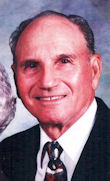 Finis Allen Brumbeloe, 92 of Midlothian, Texas, was called to be with the Lord on June 26, 2011 in Grandview, Texas surrounded by his loving family. He was born October 4, 1918 in Midlothian, Texas, the son of the late John and Mary Brumbeloe. He was the oldest of 7 children.
Finis Allen Brumbeloe, 92 of Midlothian, Texas, was called to be with the Lord on June 26, 2011 in Grandview, Texas surrounded by his loving family. He was born October 4, 1918 in Midlothian, Texas, the son of the late John and Mary Brumbeloe. He was the oldest of 7 children.
On February 21, 1942, he married the love of his life, Lucille Turner. Finis was a member of the First United Methodist Church in Midlothian and the Masonic Lodge. He lived a full life retiring from the Midlothian Postal Service.
He proudly served his country as a pilot during World War II in the US Army Air Corp as 1st Lieutenant. He loved the outdoors and thought you should always be up and moving and accomplishing something during your time here on earth.
He was preceded in death by his mother and father, Mary and John, his wife of 59 years, Lucille, brother Jake and sisters, Frances and Cleo. Finis is survived by his three daughters, Elaine Lundberg and husband, Gary of Hamilton, Mary Husfeld of Grand Prairie and Johnnie McDonald and husband, Mike of Midlothian, grandchildren, Karen Zembraski and husband, Jeff of Argyle, Barbie Uskovich and husband, Bryan of Dallas, Mariann Rogers and husband, Rick of Jacksonville, N.C., Paul Allen Lundberg and wife, Cara of Allen,and Krystal Salazar of Midlothian, great-grandchildren, Rachel and Zachary Zembraski, Finis Briggs Uskovich, Jake and Pierce Lundberg, Samantha Bell, Nick and Casi Rogers, and Aaron Salazar, brother, Ward Brumbeloe, sisters, Joyce Holveck and husband, Gunnie and Lois Duvall and husband, Cecil, brother-in-law, J.T. Turner, sister-in-law, Mary Turner and many wonderful nieces and nephews. In lieu of flowers the family requests that contributions be made to First United Methodist Church, 800 S. 9th St., Midlothian, Mission Hospice, 505 N. Ridgeway, #173, Cleburne, Tx 76033 or Grandview Nursing Center, 301 W. Criner, Grandview, Tx 76050.
Visitation will be 6:00-8:00 p.m. on Wednesday, June 29, 2011 and services will be held at 10:00 a.m. on Thursday, June 30, 2011 at Midlothian Funeral Home. Burial will follow at St. Paul’s Cemetery, Mansfield, Texas
 John L. Hunt, age 88, passed away on Monday, June 6, 2011.
John L. Hunt, age 88, passed away on Monday, June 6, 2011.
He was born Dec. 24, 1922, in Cleveland, Ohio the son of John F. and Gladys T. (Howse) Hunt. John spent his childhood years in Geneva, Ohio and graduated from Platt R. Spencer High School in 1940. He served in the Army Air Corps during World War II and was assigned to the 303 Bomb Gp, 8 AF, located at Molesworth, England. John flew 35 missions as a B-17G tail gunner and received numerous medals to include the purple heart.
John was united in marriage to Charlotte Smith on March 31, 1945, at Truax Field in Madison. He was a resident of Pardeeville for 60 years and was employed at General Indicator Corporation for many of those years. He worked at Ray's Fine Foods in Pardeeville until retirement in 1985. John had been a resident of Serenity Homes assisted living facility in DeForest since 2007. He was a member of the United Methodist Church and the American Legion.
John is survived by children, Jean (Mike) Fox of Chandler, Ariz., Tom (Tracy) Hunt of DeForest, and Beth (Jim) Chaja of Murrieta, Calif.; seven grandchildren; three great-grandchildren; sister, June; sister-in-law, Lucille Hunt of Ashtabula, Ohio; and other near relatives and dear friends.
He was preceded in death by his wife; his parents; and brothers, James, Robert and Richard.
Memorials may be made to the United Methodist Church or HospiceCare Inc. The family would like to thank the staffs at Serenity Homes, the Madison VA Hospital and HospiceCare Inc. for their compassionate and attentive care. The Smith Funeral Home in Pardeeville is serving the family.

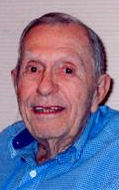 Alexander Conwell "Connie" Strickland. Our beloved husband, father and grandfather, Alexander Conwell "Connie" Strickland, Jr. passed away on Sunday, 19 June 2011 in Las Cruces, New Mexico, surrounded by the love of his life Reba and their family.
Alexander Conwell "Connie" Strickland. Our beloved husband, father and grandfather, Alexander Conwell "Connie" Strickland, Jr. passed away on Sunday, 19 June 2011 in Las Cruces, New Mexico, surrounded by the love of his life Reba and their family.
Connie and Reba lived at The Village at Northrise for the past many years where they were loved and well cared for, and Reba will continue to live there among friends. Connie was born 20 December 1920 in Groesbeck, Texas, to Alexander Conwell Strickland, Sr. and Mary Elizabeth (Henderson) Strickland. His strong faith in God holds him in good stead with the Lord, and we are comforted knowing that he will be received with open arms in Heaven.
He and his father sang many duets in the various Baptist Churches that they belonged to during his life, and their singing was gloriously enhanced by the music of his mother who was a gifted pianist. He is survived by his wife Reba May (Pool) Strickland, daughter Mary Pamela Vick and her husband Austin L. Vick of Las Cruces; daughter Susan Jane Hawley and her husband Lester Hawley of Denver; and son Alex Strickland III, and his wife Debra Wilcox, also of Denver. He was preceded in death by his parents in Texas and one daughter Penny Ann Garnham in Denver.
He has been entrusted to the services of Getz Funeral Home for cremation, and burial will be in the Strickland Plot of the Post Oak Cemetery near Oglesby, Texas, where the memories of Connie and four other generations will be together.
He was a wonderful father to his four children, teaching and encouraging always, and proud of their accomplishments. The example he taught of loving and respecting one's "mate" has enriched all of their lives more than words can express. His love of grandchildren -- Andrew Seymour and his wife Cathi of Silver Spring, MD; Robb Seymour and his wife Maggie of Arlington, VA; Heather and Zack Strickland of Florida and Lauren and Justin Finesilver of Denver--was always evident in his joy with them during their visits and communications. His great grandchildren and their accomplishments were something that put a smile on his face as well – Lauren Remington and Kylie Seymour of MD, and Aidan R. Seymour and Andrew G. Seymour of VA.
Connie began his flying career on his twenty-first birthday when he was sworn in to the Army Air Corps and then went into World War II after that. He was a highly decorated B-17 pilot during World War II stationed with the Mighty Eighth Air Force at Molesworth, England. Subsequently, he taught flying to many Air Force pilots during the Korean War in Hondo, Texas. Connie continued flying in the late 1950's in El Paso, Texas, where he was the Executive Pilot for Sam Young, Sr. and Jr. at the El Paso National Bank. He continued with the Bank after that as a Business Development Officer until his retirement.
He was a member of the First Baptist Church of Las Cruces, was a Mason and Shriner, and a charter member of several World War II historical organizations. His love of flying and airplanes as well as motorcycles never faded over these many years. His favorite hobby was watching the Dallas Cowboy football games, closely followed by building airplanes, boats, and canoes. He continued until his final days to mull over the plans and schematics to build just one more airplane. Needless to say, he will be missed by his many friends and loved ones as he takes off for this last time.
The family requests that donations be made to Mesilla Valley Hospice, 299 E. Montana, Las Cruces, NM 88005, (575) 523-4700. Arrangements by Getz Funeral Home and Getz Family Crematory corner of Solano and Bowman Ave., Las Cruces, NM 526-2419.
Lee Eldridge Dolan Jr. 92, of Frederick County, Va., died June 16, 2011, in Winchester Medical Center.
Mr. Dolan was born in 1918, in Massey's Mill, Va., the son of the late Lee E. Dolan Sr. and Hattie Dolan Bailey. He was a retired Electrical Engineer with the Department of Defense. He attended First Christian Church. Mr. Dolan was a graduate of Virginia Tech receiving a Bachelor of Science Degree in Electrical Engineering. He was a Veteran during World War II having served in the United States Air Force and the Air Force Reserves. He was stationed in England, serving with the 303rd Bomb Group "Hells Angels". Mr. Dolan achieved the rank of Major.
He married Naomi Marie Dalton on June 1, 1941, in Lynchburg, Va. Surviving with his wife, are a son and two daughters; Doug Dolan and his wife, Cheryl, of Martinsburg, W. Va., Bonnie Dolan Lynch and her husband, Bryan, of Ponte Vedra Beach, Fla., and Patti Dolan Rogers and her husband, Tom, of Frederick Co., Va.; eight grand-children, Anne Marie Corley, Brian Dolan, Stacie Nicandri, David Lynch, Cathy Lynch, Kelley Eck, Kimberly Thomas and Karin Denault; and sixteen great-grandchildren. One brother, James Dolan, preceded him in death.
A memorial service will be conducted at 11 a.m. on Wednesday, at Omps Funeral Home, South Chapel with Pastor Joan Rainsberger officiating. Interment will be in Shenandoah Memorial Park Mausoleum, Frederick County, Va. A reception and light refreshments will follow the interment at Spring Arbor. The family will receive friends from 10 to 11 am on Wednesday, at Omps Funeral Home, South Chapel.
Memorial contributions may be made to Blue Ridge Hospice, 333 W. Cork St., Suite 405, Winchester, VA 22601 or the American Diabetes Association , P.O. Box 11454, Alexandria, VA 22312.
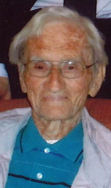 Jerry Fogle, Jr. age 91, of Aurora, passed away in his home on Sunday, June 12, 2011. He was born on May 5, 1920, in Salley, South Carolina, the son of Jerome Fogle, Sr. and Willa (Gleaton) Fogle. Jerry graduated from Aurora High School in 1938 and obtained his Bachelors Degree from Georgia Tech in 1942. After college, Jerry served in the Air Force 303rd Bombardment Group during World War II. Jerry was the president of the Aurora Bank, retiring in 1985. He was a long-time member of the First Presbyterian Church of Aurora and a member of numerous civic and fraternal organizations.
Jerry Fogle, Jr. age 91, of Aurora, passed away in his home on Sunday, June 12, 2011. He was born on May 5, 1920, in Salley, South Carolina, the son of Jerome Fogle, Sr. and Willa (Gleaton) Fogle. Jerry graduated from Aurora High School in 1938 and obtained his Bachelors Degree from Georgia Tech in 1942. After college, Jerry served in the Air Force 303rd Bombardment Group during World War II. Jerry was the president of the Aurora Bank, retiring in 1985. He was a long-time member of the First Presbyterian Church of Aurora and a member of numerous civic and fraternal organizations.
On June 15, 1947, he married Dorothy Hobbs in Aurora. She preceded him in death on September 9, 1985. He married Melva L. Morrison in Las Vegas, Nevada on March 23, 1990.
He was preceded in death by his parents, stepmother, Josephvene, brother, Anelle Fogle and sister, Gloria Holland.
Survivors include: his wife, Melva, three sons, David Fogle of Basking Ridge, New Jersey, Mark Fogle and his wife Phyllis, of Moberly, Missouri, and Brian Fogle and his wife Renee of Springfield; three grandchildren, Andrew Fogle of Washington, DC, Betsy Fogle and Ellen Fogle both of Springfield, Melva's children, Dan Morrison and his wife, June, of Gainesville, Missouri, Brad Morrison and his wife, Shana, of St. Joseph, Missouri, and Michele Slone of Springfield; and their children and grandchildren; his brother, Dr. Philip Fogle of Springfield, and his two sisters, Genevieve Bates of Springfield and Patsy Leong of Colorado Springs, Colorado; and several nieces and nephews.
A funeral service, under the direction of the Crafton-Cantrell Funeral Home, will be held at 11:00 a.m. on Thursday, June 16, 2011 at the First Presbyterian Church in Aurora with burial at the Maple Park Cemetery. Visitation will be held from 6:00-8:00 p.m. on Wednesday, June 15, in the funeral home chapel. Memorial donations may be made to the charity of your choice in Jerry's memory.
![]()
Gary,Thanks for the coverage in the last issue of events at RAF Molesworth on 13 May 2011 honoring 303rd Bomb Group veterans on the 68th anniversary of the day "Hell's Angels" became the first B-17 in the Eighth Air Force to complete 25 combat missions. I was invited as guest speaker to represent every air crew, ground crew and staff person who served in the 303rd, and to tell the way it was for us at Molesworth during World War II. It was an honor and a privilege to have that opportunity. Joint Analysis Center Historian Peter Park wrote a nice article and provided photos to illustrate the story. JAC Commander Colonel Matthew Glunz and his staff are making sure that the 303rd Bomb Group legacy continues to inspire soldiers, sailors, airmen, marines and civilians engaged in the Center's intelligence production mission.
It's also reassuring to know that your work in producing "The Molesworth Pilot" is continuing the legacy for all of us, everywhere.
Eddie Deerfield
Former 303rd BGA President and "Hell's Angels Newsletter" Editor
Omaha Beach, 6 June 2011: Martine and I were in Normandy last Monday for the celebration of D-Day. On this occasion we have placed flowers on the graves of Robert O'CONNOR and Richard PETERSON. With many thoughts for you and for all the crew of "The Mugger".Jacky EMERY
Sir Gary L. Moncur,
The famous Pointe du HOC beaches of Normandy
D-Day 06 June 2011: On this historic day I have a thought for all those young Americans who sacrificed their lives for our freedom. And special thoughts of your friends on the 303rd Bomber Group.Our gratitude and friendship,
Jean-Paul Favrais, 35310 Breal, France.
Thank you for all that information concerning the 303rd BG. We commemorated the crash of B17 "Yardbird" this May 29th in Pleubian FRANCE.
Pilot Lt. Joseph TROJAN , died in February 2008. This hero came to visit the crash site in 2000. We will never forget these young Americans come to defend our freedom! Our gratitude will be eternal!
Major Alain PADEL
Gary, you are doing a fine job of keeping the legacy alive. We are all proud of you, and for your Dad, I, as Ops Officer of the 359th Squadron was proud as hell to have him in the Squadron. He was ALWAYS up for ANY mssion I needed him to fly. He was one of my best.
Cheers, Bill Heller
A very special thank you for all you have done to keep the memories and tributes alive.
Gwen Gollotte
Sister of Victor G. Hand, 303rd Bomb Group, 427thTHANK YOU GARY, FOR THE NEWSLETTER. I AM BLESSED LIVING IN "SADDLERIDGE LODGE" IN MIDLAND, TEXAS. MANY VETS LIVE HERE.. I AM BLESSED..
XOXOXO
SIOUX CITY SUE
CAROLE JEAN (ANDERSON) WHITTEN
WIDOW OF CLEVELAND WOODWARD WHITTEN, JR.Thank you, Gary, for another memorial to the 303rd. Also, I am glad to see at last an image of the artist who creates these memorials. Such treasures for those who are blessed to read them!
Jeanne Hand Henry

|
